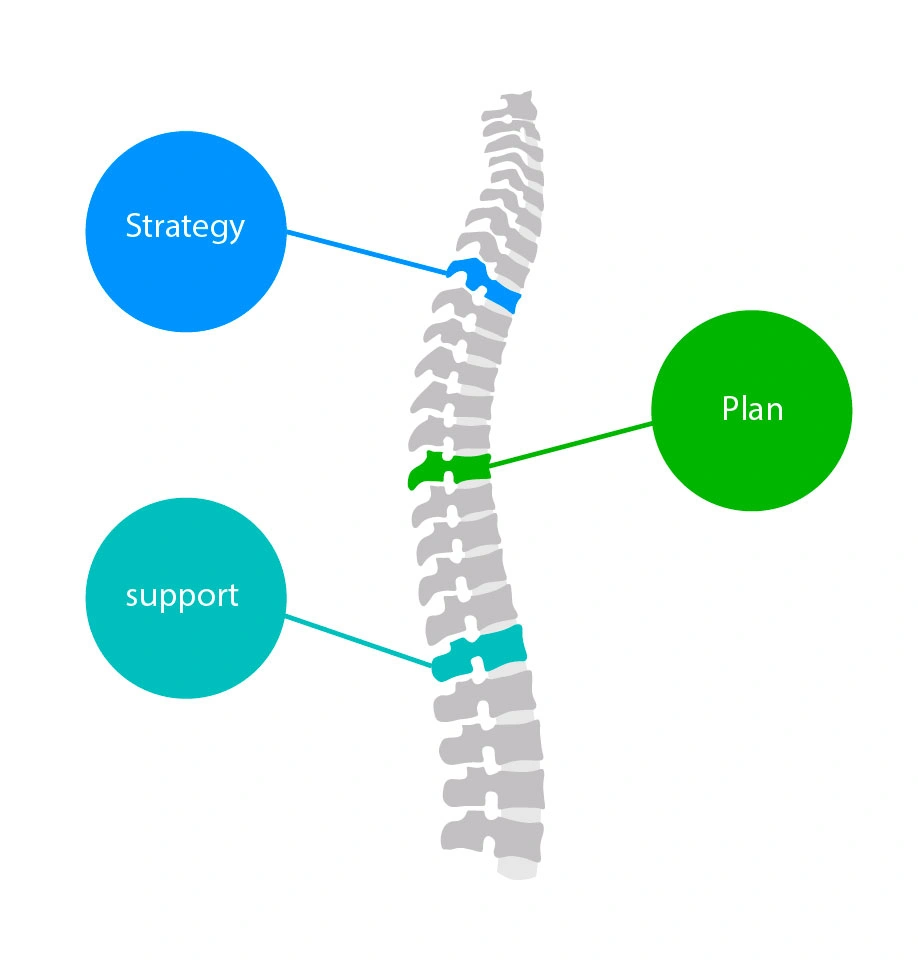
Developing your “Data Spine” through a centrally-trained data “Hub of Excellence”
Not everyone in your organization is a doctor, so why should we expect them to be?
How much data do you need to identify an opportunity for a business decision? Recognizing opportunities is the difference between modern data science and good old reliable management science. Increasingly, data is used to modify future activities in order to resolve and/or respond to a developing situation or condition, but the perceived inability to access relevant
data is a constant complaint. The truth is, we have data in abundance, as well as the technology and skills to extract value from it. What we don’t always have is a systematic approach to identifying the opportunity, analyzing it, executing it, and then tracking performance.
Is your disjointed data giving you a headache?
Constructing a well-aligned, functional data strategy is critical for any enterprise and may be coined as developing a healthy data spine.
All too often, organizations undercut their ability to execute a clear strategy for analyzing new information by training multiple staffers across multiple teams to run analytics, as opposed to creating a central hub or shared analytics department. The CGT: Retail and Consumer Goods Analytics Study 2018
shows that for the retail industry, nearly 40% of analytics responsibilities are handled by the IT department, as opposed to who should be responsible: a center of analytics excellence within the organization (7%). In the consumer industry, over 45% of these duties full into multiple departments with many spokes, as opposed to a central analytics hub (only 18%). Ultimately, being able to establish organizational discipline around analytics will become key to an enterprise’s success.
A more-centralized and connected approach to your data
So why is a central hub so important for your company? Because as with any strategic business operation, it makes sense to have a common set of goals, which is harder to achieve across multiple teams or divisions. And what are the key components to a healthy data spine? Perhaps most importantly, analytic tools and skill sets must be shared within a central department and a well-defined career path should be developed for your analysts. Moreover, having a clear picture of what is expected will drive success on a repeatable basis. Your organization should break its approach into several components, linked by the decisions you expect your users to make.
To begin the process, understand the different types of analytics and analyses you require to run your business:
- Descriptive Analytics — the backbone of reporting—it’s impossible to have business intelligence tools without it. Addresses your basic how many, when, where, and what questions and includes the analysis of the effectiveness of the operational execution.
- Predictive Analytics — may be the most commonly used category of data analytics as it is used to identify trends, correlations, and causation. Enables the user to create/plan an activity, such as a promotion, and have the solution provide an impact analysis on volume and trade spend forecasting. These outputs would include those metrics for value; i.e., incremental volume, weeks incremental volume, spend rate, margin impact, incremental return on investment, that would allow the user to determine
is this a promotion I want to include in my account plan?
and if so, save it and move on to the next activity. - Directional or Prescriptive Analytics — where AI and big data meet to help predict outcomes and what actions to take. Combines the insights from predictive analytics with business rules and practices to provide the users with coherent recommendations for list prices, promotional plans, etc. These recommendations are based on mathematically optimized decision-making techniques.
- Contextual or Performance Analytics — Enables a user to evaluate how an activity or campaign performed—actual results versus planned expectations. Performance analytics can be focused on one activity (a promotion) or a series of actions (annual volume plan), depending on what decisions can be made following that performance evaluation.
As channels blur and consumer purchasing, consumption behavior, and new trends in data analytics (especially fueled by AI and machine learning) continue to evolve, identifying a resource to focus on new ways to look at the avalanche of data will be key to your future success.
It is our belief that establishing an Analytics Center of Excellence
is one way to achieve this. This small group of highly skilled analysts would support all teams (Marketing, Sales, Finance, Operations, Supply Chain, etc.) in the development of new and innovative insights across new products, competitors, partners, and consumers. The responsibility to find value in the sea of information should have focus, with predefined analytics in place that are both standardized and distributed to users across any team.
Whether your focus is on plan accuracy, execution performance, reactive insights, or all of the above, directing the right data to the right users at the right time for meaningful decision making comes from building a strong platform with the smartest people in place. It’s not just all about the numbers. Insight-based decisions within an Analytics Center of Excellence, based on a healthy data spine, will establish a clear foundation for growth–in both the short and long term.
Download our eBook Building a better analytics framework
to learn more
Get the latest news, updates, and exclusive insights from Vistex delivered straight to your inbox. Don’t miss out—opt in now and be the first to know!

